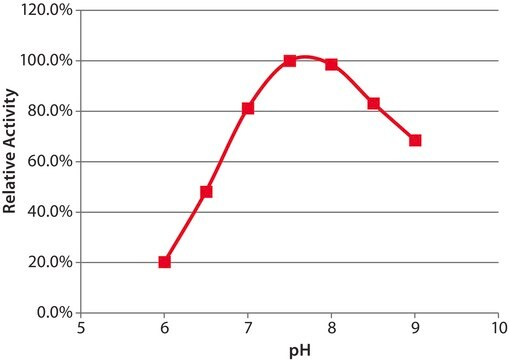C2888
Acetylcholinesterase from Electrophorus electricus (electric eel)
Type V-S, lyophilized powder, ≥1,000 units/mg protein
Synonym(s):
AChE, Acetylcholine acetylhydrolase, Cholinesterase, Acetyl
Sign Into View Organizational & Contract Pricing
All Photos(7)
About This Item
Recommended Products
biological source
Electrophorus electricus
Quality Level
type
Type V-S
form
lyophilized powder
specific activity
≥1,000 units/mg protein
mol wt
280 kDa
composition
Protein, ≥45% biuret
pI
~5.3
solubility
Tris buffer: 1 mg/mL (0.02 M Tris buffer, pH 7.5)
storage temp.
−20°C
Looking for similar products? Visit Product Comparison Guide
General description
Molecular Weight: 280 kDa
Isoelectric Point: 5.5
Extinction Coefficient: E1% = 18.0 (280 nm)
Acetylcholinesterase from Electrophorus electricus is a tetramer composed of 4 equal subunits of 70 kDa each. Each subunit contains one active site. The enzyme is a glycoprotein containing hexosamines.
Isoelectric Point: 5.5
Extinction Coefficient: E1% = 18.0 (280 nm)
Acetylcholinesterase from Electrophorus electricus is a tetramer composed of 4 equal subunits of 70 kDa each. Each subunit contains one active site. The enzyme is a glycoprotein containing hexosamines.
Application
Acetylcholinesterase from Electrophorus electricus (electric eel) has been used:
- in acetylcholinesterase activity assay
- to study its effects on Xenopus embryonic hippocampal cells
- to study the effect of acetylcholine inhibitors on development and plasticity
Biochem/physiol Actions
Acetylcholinesterase (AChE) exhibits its activity against acetylcholine in the neuromuscular junctions and synaptic cleft of cholinergic neurons. It participates in the nitric oxide signaling pathway.
Major degradative enzyme for acetylcholine in vivo. Converts acetylcholine + H2O to choline + acetic acid.
Caution
For dilute solutions (<1 mg/ml), add 1 mg/ml BSA to stabilize. Solutions containing at least 1 mg protein/ml in dilute neutral phosphate buffer are stable at least 6 months refrigerated.
Unit Definition
One unit will hydrolyze 1.0 μmole of acetylcholine to choline and acetate per min at pH 8.0 at 37 °C.
Physical form
Lyophilized powder containing Tris buffer salts
Analysis Note
The activity obtained using acetylcholine as substrate is 30-100 times that obtained with butyrylcholine, using acetylcholinesterase from electric eel.
Storage Class Code
11 - Combustible Solids
WGK
WGK 3
Flash Point(F)
Not applicable
Flash Point(C)
Not applicable
Personal Protective Equipment
dust mask type N95 (US), Eyeshields, Gloves
Choose from one of the most recent versions:
Already Own This Product?
Find documentation for the products that you have recently purchased in the Document Library.
Customers Also Viewed
Daniela Pereira et al.
Marine drugs, 19(1) (2020-12-31)
Over the last decades, antifouling coatings containing biocidal compounds as active ingredients were used to prevent biofouling, and eco-friendly alternatives are needed. Previous research from our group showed that polymethoxylated chalcones and glycosylated flavones obtained by synthesis displayed antifouling activity
Silvia Olivera et al.
Molecular and cellular neurosciences, 23(1), 96-106 (2003-06-12)
Here we show that chronic application of low concentrations (0.01-0.05 U/ml) or a single application of 1-5 U/ml acetylcholinesterase (AChE) promotes the extension of neuronal processes, synapse formation, and alpha-amino-3-hydroxy-5-methylisoxazolepropionate receptor (AMPAR) surface expression in both embryonic and postnatal hippocampal
Daniel A S Kitagawa et al.
Journal of enzyme inhibition and medicinal chemistry, 36(1), 1370-1377 (2021-06-22)
Organophosphorus poisoning caused by some pesticides and nerve agents is a life-threating condition that must be swiftly addressed to avoid casualties. Despite the availability of medical countermeasures, the clinically available compounds lack a broad spectrum, are not effective towards all
Nagham Alatrash et al.
ChemMedChem, 12(13), 1055-1069 (2017-06-13)
Four mononuclear [(L-L)2 Ru(tatpp)]2+ and two dinuclear [(L-L)2 Ru(tatpp)Ru(L-L)2 ]4+ ruthenium(II) polypyridyl complexes (RPCs) containing the 9,11,20,22-tetraazatetrapyrido[3,2-a:2',3'-c:3'',2''-l:2''',3'''-n]pentacene (tatpp) ligand were synthesized, in which L-L is a chelating diamine ligand such as 2,2'-bipyridine (bpy), 1,10-phenanthroline (phen), 3,4,7,8-tetramethyl-1,10-phenanthroline (Me4 phen) or 4,7-diphenyl-1,10-phenanthroline
Neda Rafat et al.
Biosensors, 11(11) (2021-11-26)
A novel, integrated experimental and modeling framework was applied to an inhibition-based bi-enzyme (IBE) electrochemical biosensor to detect acetylcholinesterase (AChE) inhibitors that may trigger neurological diseases. The biosensor was fabricated by co-immobilizing AChE and tyrosinase (Tyr) on the gold working
Our team of scientists has experience in all areas of research including Life Science, Material Science, Chemical Synthesis, Chromatography, Analytical and many others.
Contact Technical Service







